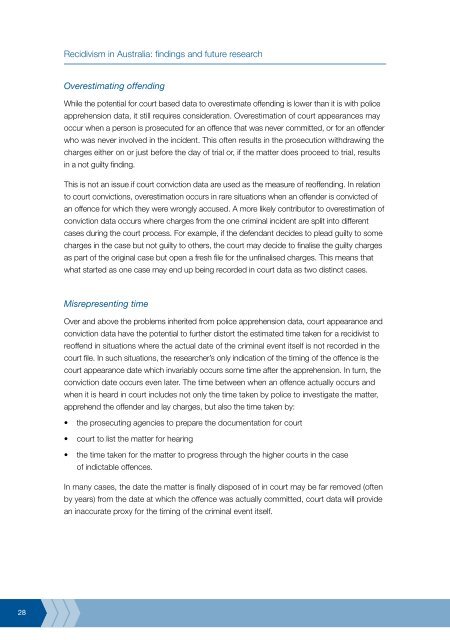Recidivism in Australia : findings and future research - Australian ...
Recidivism in Australia : findings and future research - Australian ...
Recidivism in Australia : findings and future research - Australian ...
Create successful ePaper yourself
Turn your PDF publications into a flip-book with our unique Google optimized e-Paper software.
28<br />
<strong>Recidivism</strong> <strong>in</strong> <strong>Australia</strong>: f<strong>in</strong>d<strong>in</strong>gs <strong>and</strong> <strong>future</strong> <strong>research</strong><br />
Overestimat<strong>in</strong>g offend<strong>in</strong>g<br />
While the potential for court based data to overestimate offend<strong>in</strong>g is lower than it is with police<br />
apprehension data, it still requires consideration. Overestimation of court appearances may<br />
occur when a person is prosecuted for an offence that was never committed, or for an offender<br />
who was never <strong>in</strong>volved <strong>in</strong> the <strong>in</strong>cident. This often results <strong>in</strong> the prosecution withdraw<strong>in</strong>g the<br />
charges either on or just before the day of trial or, if the matter does proceed to trial, results<br />
<strong>in</strong> a not guilty f<strong>in</strong>d<strong>in</strong>g.<br />
This is not an issue if court conviction data are used as the measure of reoffend<strong>in</strong>g. In relation<br />
to court convictions, overestimation occurs <strong>in</strong> rare situations when an offender is convicted of<br />
an offence for which they were wrongly accused. A more likely contributor to overestimation of<br />
conviction data occurs where charges from the one crim<strong>in</strong>al <strong>in</strong>cident are split <strong>in</strong>to different<br />
cases dur<strong>in</strong>g the court process. For example, if the defendant decides to plead guilty to some<br />
charges <strong>in</strong> the case but not guilty to others, the court may decide to f<strong>in</strong>alise the guilty charges<br />
as part of the orig<strong>in</strong>al case but open a fresh file for the unf<strong>in</strong>alised charges. This means that<br />
what started as one case may end up be<strong>in</strong>g recorded <strong>in</strong> court data as two dist<strong>in</strong>ct cases.<br />
Misrepresent<strong>in</strong>g time<br />
Over <strong>and</strong> above the problems <strong>in</strong>herited from police apprehension data, court appearance <strong>and</strong><br />
conviction data have the potential to further distort the estimated time taken for a recidivist to<br />
reoffend <strong>in</strong> situations where the actual date of the crim<strong>in</strong>al event itself is not recorded <strong>in</strong> the<br />
court file. In such situations, the <strong>research</strong>er’s only <strong>in</strong>dication of the tim<strong>in</strong>g of the offence is the<br />
court appearance date which <strong>in</strong>variably occurs some time after the apprehension. In turn, the<br />
conviction date occurs even later. The time between when an offence actually occurs <strong>and</strong><br />
when it is heard <strong>in</strong> court <strong>in</strong>cludes not only the time taken by police to <strong>in</strong>vestigate the matter,<br />
apprehend the offender <strong>and</strong> lay charges, but also the time taken by:<br />
•<br />
•<br />
•<br />
the prosecut<strong>in</strong>g agencies to prepare the documentation for court<br />
court to list the matter for hear<strong>in</strong>g<br />
the time taken for the matter to progress through the higher courts <strong>in</strong> the case<br />
of <strong>in</strong>dictable offences.<br />
In many cases, the date the matter is f<strong>in</strong>ally disposed of <strong>in</strong> court may be far removed (often<br />
by years) from the date at which the offence was actually committed, court data will provide<br />
an <strong>in</strong>accurate proxy for the tim<strong>in</strong>g of the crim<strong>in</strong>al event itself.















